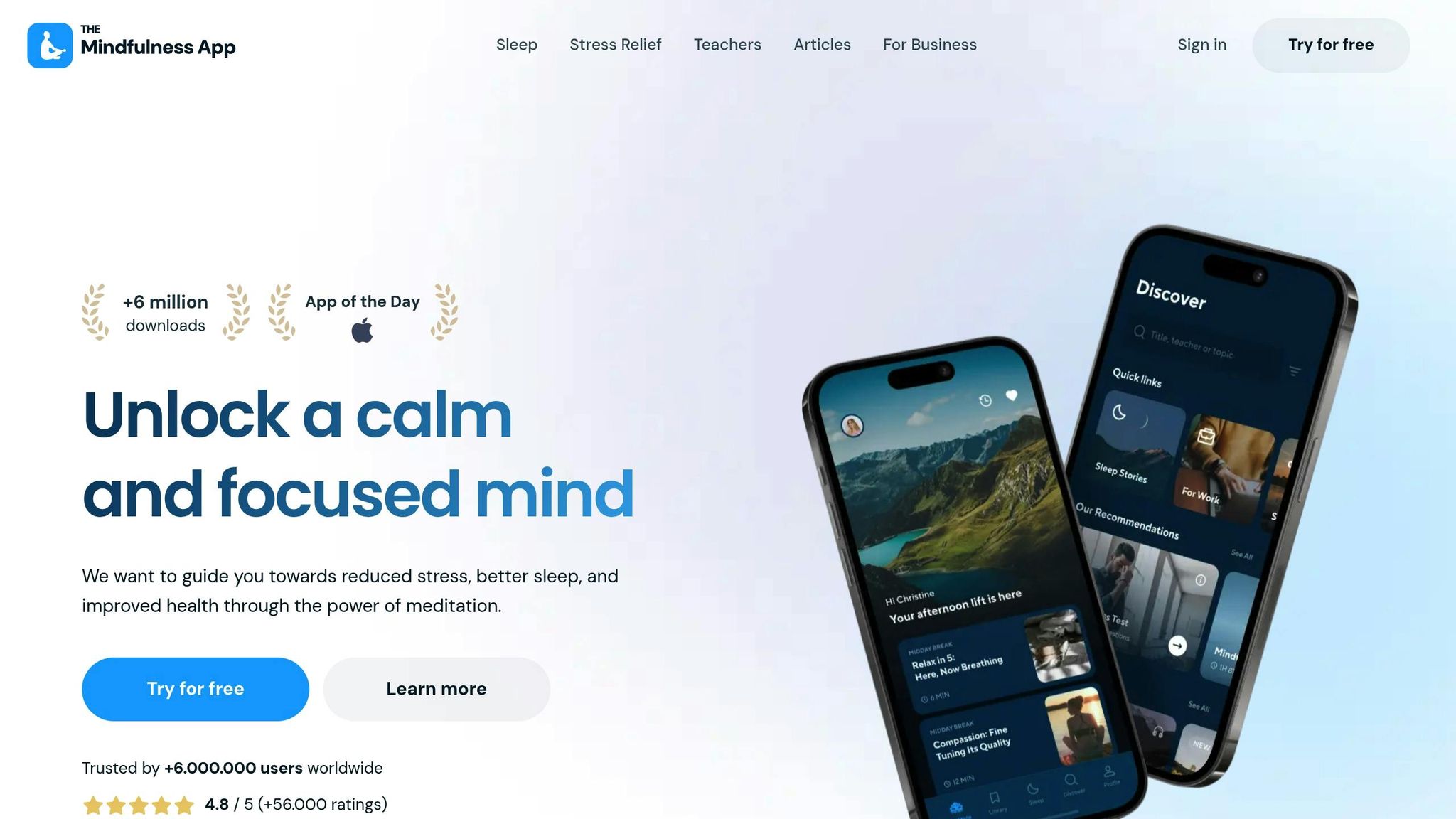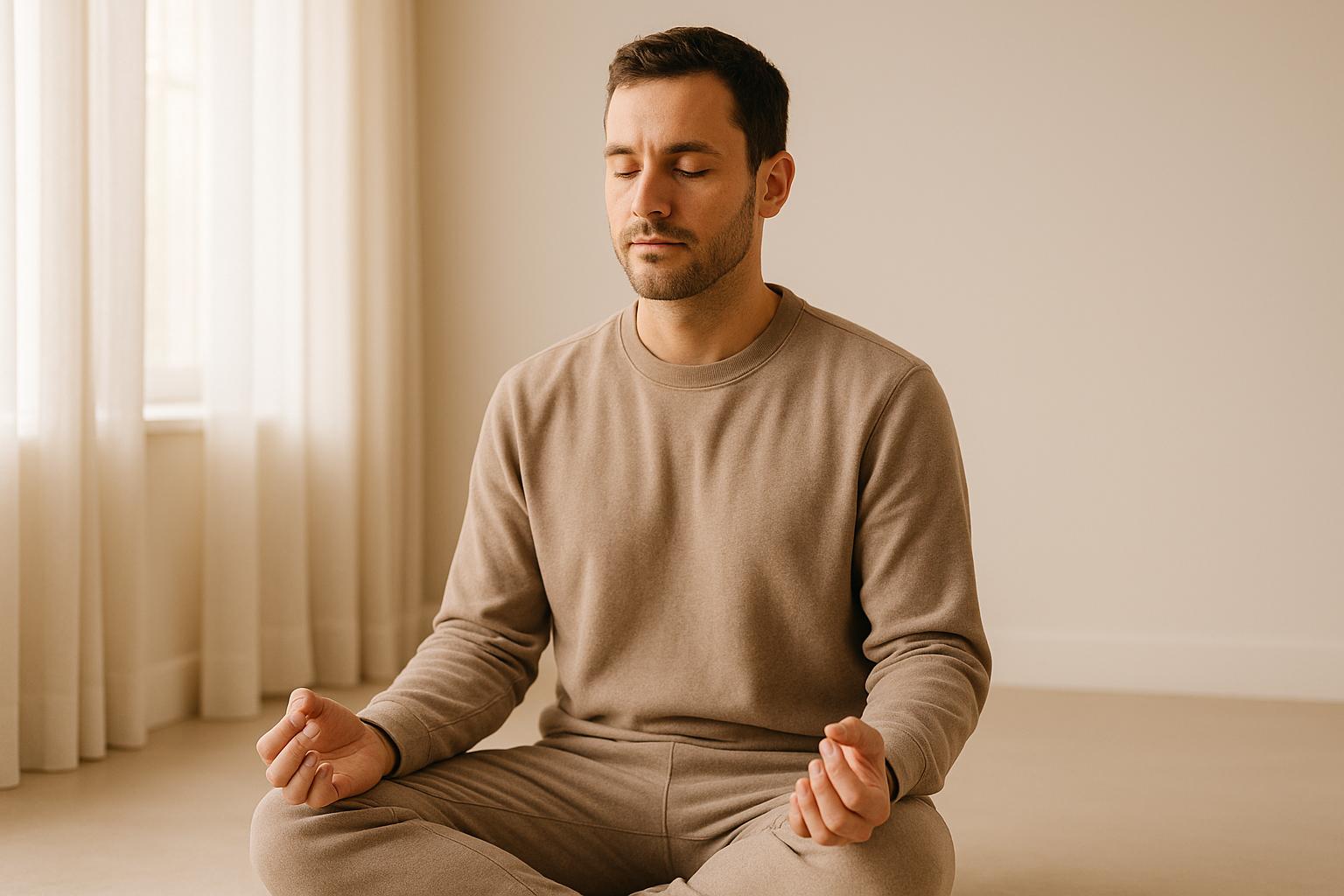Mindfulness can help you build better habits by increasing self-awareness and breaking automatic behavior patterns. Instead of relying on willpower alone, mindfulness allows you to notice triggers, pause, and choose intentional responses. This approach works by disrupting the habit loop of trigger-behavior-reward, helping you replace unhelpful routines with healthier ones.
Here’s how mindfulness supports habit formation:
- Identify triggers: Recognize what prompts your habits, like stress or boredom.
- Pause and reflect: Create space between a trigger and your response to make deliberate choices.
- Handle setbacks: Approach missed goals with curiosity instead of self-criticism.
- Focus on small steps: Start with manageable actions, like 5 minutes of mindful breathing daily.
To make mindfulness part of your routine, pair it with existing habits (e.g., practice mindful breathing after brushing your teeth) and use reminders like phone alarms or sticky notes. Consistency matters more than intensity - small daily efforts lead to lasting change. Tools like meditation apps can also help by offering guided practices and tracking progress.
Mindful habit formation is about observing your behaviors, making intentional changes, and staying flexible as life evolves. Over time, this practice can help you create meaningful, lasting habits that align with your goals.
A Practical Plan for Changing Habits | Mindful Tips | Mindful Movement
Core Principles of Mindful Habit Formation
Creating lasting habits through mindfulness is about understanding how your mind works and using that knowledge to make meaningful changes. This process rests on three key principles: recognizing the habit loop, being purposeful in your approach, and committing to daily practice.
Recognizing Triggers, Routines, and Rewards
Every habit operates within a structure known as the habit loop. This loop begins with a trigger (the cue that initiates the behavior), moves to the routine (the action you take), and ends with a reward (the benefit you gain). Most of the time, this cycle runs on autopilot.
Mindfulness helps you slow down and notice these patterns, giving you the chance to disrupt automatic responses. Instead of reacting without thinking, you create a moment to choose how to respond. Sam Dabir, a medical sciences student at Western University, explains:
"Practicing mindfulness can also help break bad habits by slowing down the decision-making process and allowing for more conscious choices. Being mindful of your triggers and behaviors helps disrupt the automatic habit loop, giving you more control over your actions."
Charles Duhigg, a well-known habit researcher, highlights the importance of this awareness:
"Once you diagnose the cue, the routine, and the reward - you gain power over it."
For example, let’s say you notice that boredom (trigger) leads you to pick up your phone and scroll through social media (routine), which gives you a small burst of entertainment (reward). Once you recognize this loop, you can experiment with new routines that offer the same reward - like stepping outside for fresh air or doing a quick breathing exercise.
The key is to observe these patterns with curiosity, not judgment. This understanding lays the groundwork for making intentional, meaningful changes to your habits.
Being Purposeful in Habit Building
Mindfulness doesn’t just reveal your habits - it helps you stay committed to changing them. Building habits mindfully requires intentionality, or being clear about your purpose. Without a strong sense of "why", it’s easy to lose motivation when challenges arise.
Start by identifying what you truly want to achieve. Instead of saying, "I want to exercise more", dig deeper: "I want to have more energy during the day" or "I want to sleep better at night." This clarity keeps you grounded and motivated, even when the initial enthusiasm fades.
It’s also important to focus on quality over quantity. Rather than attempting to change multiple habits at once, prioritize one or two that will make a big difference in your life. This focused approach allows you to give your full attention to the process, making it easier to establish lasting patterns.
Mindfulness strengthens your ability to make deliberate choices. Each time you pause to reflect, you’re training your brain to act with intention. Over time, this practice becomes second nature, making it easier to stick with your new habits. To support these intentional efforts, consistency is essential.
The Importance of Daily Practice
When it comes to forming mindful habits, consistency matters more than intensity. A small daily effort is far more effective than occasional bursts of activity. Repetition is what helps your brain build and reinforce the neural pathways that turn actions into habits.
Daily mindfulness practice plays a crucial role in this process. It boosts your overall awareness and self-control, helping you notice triggers and respond thoughtfully. It also fosters a sense of calm and focus that supports your broader habit-building efforts.
The good news? You don’t need to dedicate hours to mindfulness to see results. Even five minutes a day can make a difference. This could mean doing a quick body scan in the morning, practicing mindful breathing during a break, or reflecting on your day before bed.
To make mindfulness itself a habit, tie it to something you already do regularly. For instance, you could practice mindful breathing right after brushing your teeth or meditate for a few minutes before checking your email.
Regular practice also helps you recover from setbacks more easily. If you miss a day or fall back into old habits, mindfulness allows you to notice what happened without being overly critical. This self-compassion makes it easier to regroup and move forward, instead of abandoning your efforts altogether.
Step-by-Step Guide to Building Mindful Habits
Ready to turn mindfulness into a daily habit? Follow these steps to make it part of your routine in a way that feels natural and achievable.
Set a Clear Goal
Every successful habit starts with a well-defined goal. Saying something vague like "I want to be more mindful" won’t get you very far. Instead, aim for a specific and measurable goal.
Pick one habit to focus on - something small but meaningful. For instance, instead of saying, "I’ll meditate more", commit to "I’ll spend 5 minutes on mindful breathing every morning right after I wake up." This level of detail eliminates guesswork and makes it easier to follow through.
Decide when and where you’ll practice your habit. Maybe it’s journaling gratitude at the kitchen table every evening at 8:00 PM or doing a quick body scan before bed. The key is to make it fit seamlessly into your current lifestyle. If you’re new to mindfulness, start small - just 3 to 5 minutes a day - and build from there.
Write your goal down and put it somewhere you’ll see it daily. This simple act not only reinforces your commitment but also serves as a constant reminder of your intention.
Add Mindfulness to Your Current Routines
The easiest way to form a new habit? Attach it to something you already do every day. This approach, known as habit stacking, uses your existing routines as a foundation for your new behavior.
Take a look at your daily schedule and find natural opportunities to add mindfulness. For example:
- After brushing your teeth, spend three minutes on mindful breathing.
- While waiting for your coffee to brew, do a quick body scan to check in with yourself.
- During your commute, practice mindful listening by noticing the sounds around you.
Anchor your habit to behaviors that are already automatic, like turning on your car, washing your hands, or opening your laptop. The more ingrained the anchor, the easier it’ll be to remember your new habit.
Start with actions that take less than two minutes. Small steps make a big difference. If you want to practice mindful eating, start by taking three deep breaths before each meal. If better sleep is your goal, do a one-minute body scan when you get into bed. These tiny actions may seem insignificant, but they lay the groundwork for bigger changes.
Look for moments of transition in your day - like sitting down at your desk or finishing a meeting. These are perfect times to pause and insert a brief mindfulness practice, such as setting an intention for the next activity.
Use Reminders and Track Your Progress
Consistency is key, and reminders can help you stay on track, especially in the beginning.
Place physical cues where you’ll notice them. Want to practice mindful breathing? Stick a note on your bathroom mirror or computer screen. For mindful eating, try a reminder on your refrigerator. These visual prompts are especially helpful during the first few weeks when the habit hasn’t become automatic yet.
You can also set phone alarms or notifications, but make them purposeful. Sync them with your habit anchors - like setting a reminder to pause for mindfulness when you start brewing coffee.
Keep track of your progress with a simple calendar. Marking off each day you stick to your habit creates a visual record of your consistency. If you prefer digital tools, apps like The Mindfulness App can track your meditation streaks and show your progress over time. This kind of gentle accountability can keep you motivated when your enthusiasm dips.
Take time to review your progress weekly. While daily tracking keeps you consistent, a weekly check-in helps you spot patterns. If you notice you often miss your habit on certain days, you can tweak your plan instead of giving up altogether.
And if you do miss a day? Don’t sweat it. Avoid the "all-or-nothing" mindset. Missing one day doesn’t erase all your progress. Instead, reflect on what got in the way, adjust as needed, and pick up where you left off the next day. Practicing self-compassion is just as important as the habit itself.
sbb-itb-bea8dce
Tools and Resources for Mindful Habit Formation
Building mindful habits becomes much easier when you have the right tools and resources seamlessly woven into your daily life. These aids reinforce the strategies discussed earlier, helping you stick to your new routines.
Practical Tools for Staying Consistent
A few simple tools can make a big difference in maintaining mindfulness:
- Use a timer - your phone's built-in app or a meditation-specific timer works great - to set a fixed practice duration, like 5 minutes. This removes uncertainty and keeps you focused.
- Track your progress with a wall calendar or a digital app. Marking each day you practice serves as a visual motivator and a reminder of your commitment.
- Spend 2–3 minutes after each session jotting down observations in a mindfulness journal. This helps you spot patterns and reflect on your progress.
- Set up environmental cues, like placing a small bell on your nightstand or keeping a gratitude journal by your coffee maker, to remind you to practice.
- Smartphone widgets can display your streak or send helpful notifications, giving you gentle nudges throughout the day.
These tools create a solid framework for consistency, which can be further enhanced with digital resources like The Mindfulness App.
How The Mindfulness App Can Help

Adding digital support to your routine can make mindfulness more accessible and structured. The Mindfulness App is a great example, offering over 500 guided meditations in 12 languages. Whether you have just 3 minutes or a full 30 minutes, there’s a session to fit your schedule, mood, and experience level.
One standout feature is its offline functionality. By downloading meditations in advance, you can practice anywhere - on a lunch break, during travel, or in areas without internet access.
The app also offers personalized meditation programs that adapt to your progress and preferences. These structured courses guide you step by step, making it easier to keep up with a regular practice.
Beyond meditation, the app includes sleep stories and courses to extend mindfulness into other parts of your day. Start your morning with breathing exercises, use midday sessions to reduce stress, and wind down at night with calming sleep stories.
For those curious about trying it out, the app provides a 14-day free trial, allowing you to explore all its features and find what works best for your routine.
Dealing with Common Problems
Even with the best tools, challenges will arise. Here’s how to tackle some of the most common obstacles:
- Forgetting to practice: Tie your mindfulness habit to something you already do daily. For instance, if you always check your phone in the morning, make opening your meditation app the first thing you do instead of scrolling through social media.
- Low motivation: On days when energy is low, focus on simply showing up. Even 60 seconds of mindful breathing counts as progress. Often, starting small leads to longer sessions once you’re in the flow.
- Getting distracted: It’s normal for your mind to wander. If you start thinking about errands or work, gently bring your focus back to your breathing. Each distraction is an opportunity to strengthen your awareness.
- Perfectionism: Don’t let a missed day or a scattered session derail your efforts. Avoid the "all-or-nothing" trap. One off day doesn’t erase your progress - use it as a chance to adjust and refine your approach.
- Time constraints: Feeling too busy? Mindfulness doesn’t require huge blocks of time. Find 5 minutes by waking up slightly earlier, meditating during your commute, or cutting back on social media. Even starting with 2 minutes can make a difference as you build the habit.
- Lack of immediate results: Mindfulness benefits often appear gradually. Keep a simple log of how you feel before and after each session. Over time, you may notice subtle improvements in mood, focus, or stress levels that become more evident when you look back over weeks.
Maintaining Your Mindful Habits Long-Term
Starting mindful habits is one thing - keeping them alive as life shifts and evolves is a whole other challenge. New schedules, responsibilities, or environments can easily throw off even the best-laid plans. The secret isn't about being perfect; it's about staying adaptable and kind to yourself as you navigate changes.
Review Your Progress Regularly
Once you've built a mindfulness routine, it's important to check in with yourself and see how it's going. A weekly review is a great way to stay on track and make adjustments.
Set aside 10-15 minutes each week - Sunday evenings, for example - to reflect on your practice. Ask yourself questions like: How many days did I practice? What felt easy? What was difficult? Did I notice any changes in my stress, sleep, or mood? Writing these reflections in a mindfulness journal can help you spot patterns and celebrate small wins.
For example, maybe you realize Monday mornings are tough for meditation because you're rushing to start the week. Or perhaps you notice that evening breathing exercises help you unwind after a stressful day. Did you practice four days this week compared to two last month? That’s progress. Did you pause to take three mindful breaths during a meeting instead of reacting on impulse? That’s a big win, too.
Some people like to track simple metrics, such as rating stress or energy levels on a scale of 1-10 before and after each session. The specific details don’t matter as much as the act of consistently observing and recording your experience.
Be Kind to Yourself
Self-compassion is essential when it comes to maintaining mindful habits. It’s easy to beat yourself up if you miss a session or feel like you’re "bad" at mindfulness, but that kind of thinking can derail your efforts faster than anything else.
If you miss a day, try to understand why without being hard on yourself. Was it a busy workday? A family emergency? Did your routine get thrown off? Use these moments as learning opportunities rather than reasons to quit. Recognizing that you’ve drifted from your practice is actually a sign of mindfulness - it shows you’re aware of what’s happening in your life.
Even small efforts count. If your usual meditation is 15 minutes but you only have 3 minutes, those 3 minutes still matter. If you miss your morning session but find a quiet moment in the afternoon, that’s just as valuable. Flexibility and self-acceptance help your practice adapt to life’s ups and downs.
Remember, building habits takes time and patience. Every time you return to your practice, you’re strengthening it. This resilience - this ability to come back to what supports you - is one of the most powerful benefits of mindfulness.
Adjust Habits When Life Changes
Life doesn’t stand still, and neither should your mindfulness routine. Whether it’s a new job, a move, or major life events, changes often mean you’ll need to tweak your habits to keep them going.
Schedule changes are a common hurdle. If you’ve been meditating at 7:00 AM but now need to leave the house earlier, try a different approach. Could you meditate for a few minutes while your coffee brews? Or maybe a short breathing exercise during your commute could work. If mornings are no longer an option, consider switching to evenings.
Environmental changes can also disrupt your routine. Moving to a new place, traveling for work, or living with people on different schedules might mean your usual practice space or time isn’t available. The good news? Mindfulness is portable. You can practice in a hotel room, on a plane, or even in a noisy coffee shop. A simple body scan or breathing exercise doesn’t require any special setup.
Energy levels fluctuate over time, and your practice can adjust to meet you where you are. During stressful periods, shorter, more frequent sessions might feel more manageable. If you’re dealing with illness or physical limitations, gentle breathing exercises can replace more active practices. Parents of young children often find that micro-meditations - like 30 seconds of mindful breathing while the baby naps - are more realistic than longer sessions.
The key is to hold onto the essence of your practice, even if the form changes. If your goal is to start the day with intention, that could mean 20 minutes of seated meditation during calm periods or 2 minutes of mindful breathing while walking to your car during busy times. Both serve the same purpose.
Consider creating different versions of your routine for varying circumstances. Have a 15-minute version for relaxed days, a 5-minute version for busier ones, and a 1-minute version for when life feels overwhelming. This way, you always have an option that fits your current situation, making it easier to stay consistent.
Technology can also be a big help during transitions. Apps like The Mindfulness App allow you to download guided meditations, so you’re not dependent on an internet connection. Having these tools ready to go removes one more barrier, especially when life gets hectic or unpredictable.
Conclusion: Using Mindfulness to Create Positive Change
Mindful habit formation isn't about striving for perfection - it's about making intentional choices. By combining mindfulness with habit-building, you gain the ability to thoughtfully respond to life's challenges rather than reacting on autopilot.
Through mindfulness, you learn to recognize the space between a trigger and your response. This moment of awareness allows you to consciously choose actions that align with your goals, rather than defaulting to ingrained routines. By understanding the cues, routines, and rewards behind your habits, you can break free from automatic behaviors and make decisions that truly serve you.
Practicing mindfulness strengthens your focus, helps regulate emotions, and fosters self-compassion. These skills create a solid foundation for meaningful and lasting changes. Moreover, mindfulness encourages you to see thoughts as temporary events, not absolute truths. When thoughts like "I’m too tired to meditate today" or "I’ll never stick to this" arise, mindfulness helps you recognize them as fleeting ideas rather than facts that control your actions. This shift in perspective is key to building habits that last.
The Mindfulness App can be a helpful companion on this journey. With over 500 guided meditations and mindfulness courses in 12 languages, it offers the structure and variety needed to keep your practice engaging. Its offline functionality ensures you can access mindfulness tools anytime - whether you're traveling, juggling a busy schedule, or simply seeking a quiet moment. Plus, the 14-day free trial gives you the chance to explore different meditation styles and find what aligns with your goals.
Resources like The Mindfulness App support you through the different stages of habit formation. Building habits through mindfulness is a gradual process that involves preparation, action, and maintenance - each stage bringing its own challenges and triumphs. Some days will feel seamless, while others might require extra patience and self-compassion. Both experiences are part of the process.
The real transformation happens when mindfulness becomes a natural part of your daily life - not just another task to check off, but a way of living with greater awareness, kindness, and purpose. Each mindful moment brings you closer to meaningful, lasting change. This integration of mindfulness into everyday routines is where the true power of this practice lies.
FAQs
How can I recognize the triggers behind my automatic habits?
Recognizing the triggers behind automatic habits begins with paying close attention to your thoughts, emotions, and physical sensations. When you tune into these reactions, you can start spotting patterns that often lead to habitual behaviors.
Practices like journaling, mindful breathing, or body scan meditations are useful tools to help you notice these triggers more clearly. Over time, this heightened awareness creates a small but crucial pause between the trigger and your response. That pause gives you the chance to make deliberate choices instead of falling into old routines.
By regularly incorporating self-reflection and mindfulness into your life, you can start breaking old habits and building new, healthier ones. Guided meditations and mindfulness exercises can be particularly helpful for staying consistent and keeping your focus on the changes you want to make.
How can I use mindfulness to build and maintain new habits?
To develop and maintain new habits through mindfulness, start with small, manageable steps. For example, try incorporating simple practices like mindful breathing or short meditation sessions into your daily routine. As you get more comfortable, you can gradually extend the duration of these practices.
Mindfulness doesn’t have to be limited to meditation. You can weave it into everyday activities like eating, walking, or even working. The key is to focus on the present moment - whether it’s savoring the taste of your food or paying attention to the rhythm of your steps. Setting reminders can help you stay consistent and build a routine. Remember, repetition is key, and research suggests it can take around 66 days of consistent effort to establish a new habit.
Another way mindfulness can support habit-building is by helping you break unhelpful patterns. By practicing non-judgmental awareness, you can observe your actions without criticism. This approach allows you to make intentional, thoughtful choices that align with healthier and more positive habits.
How can I stay consistent with mindfulness when life feels overwhelming?
Staying committed to mindfulness, even when life gets busy or stressful, becomes much more manageable when you weave simple practices into your daily routine. Just a few minutes of mindful breathing, body scans, or guided meditations each day can help you feel more centered without throwing off your schedule.
Building a habit by practicing at the same time each day - whether it's in the morning, during a lunch break, or before bed - can make mindfulness feel like a natural part of your day. If you need a little extra guidance, The Mindfulness App offers tools like guided meditations and quick exercises to help you keep up your practice, no matter how chaotic your day may be.






